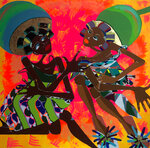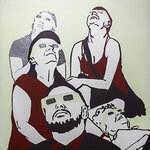The exhibition, "What is Belonging?" opens with a reception on Saturday, June 8.
This item is available in full to subscribers.
We have recently launched a new and improved website. To continue reading, you will need to either log into your subscriber account, or purchase a new subscription.
If you are a digital subscriber with an active subscription, then you already have an account here. Just reset your password if you've not yet logged in to your account on this new site.
If you are a current print subscriber, you can set up a free website account by clicking here.
Otherwise, click here to view your options for subscribing.
Please log in to continue |


For Joanne Grüne-Yanoff, an artist who has always had her "feet in two different places," the question of what it means to "belong" conjures two worlds - the familiar streets of Mt. Airy where she grew up, and the distant shores of Sweden, which she now calls home.
It's a question that Grüne-Yanoff has strived to answer through her work, and workshops where she encourages others to share their stories and create community through art. Now, she explores the tension of straddling different cultures, norms and senses of self as juror of the Woodmere Museum's 82nd Annual Exhibition, "What is Belonging?" which opens with a reception on Saturday, June 8, from noon to 4 p.m.
A reflective and creative child, Grüne-Yanoff grew up in West Mt. Airy and moved to Stockholm for work. Her creations, which span disciplines from paintings and sculptures to poetry and film, have been shaped by the experience of "always having my feet in two different places."
"It's just different manifestations, different ways of expressing the same thought," she said.
Grüne-Yanoff has held workshops in Philadelphia, Sweden and other spaces where she developed the idea for the exhibit's central piece, a large-scale work suspended in the rotunda gallery.
"In Sweden, where I live, you walk into somebody's house and take off your shoes immediately," she said. "And so there's this instant sense of this slight vulnerability."
After everyone in the group - including people from Sweden, the U.S., Afghanistan, Syria and around the world - took off their shoes, they would trace their footprints as an icebreaker. Next, Grüne-Yanoff would tell a story, a jumping-off point for conversations about home, flight and belonging.
"A lot of my work stems from that focus of being an immigrant in the different places that I've moved to, and thinking like the family that I grew up with, or the city that I grew up in that created so much of my sense of self, they weren't right there," she said. "Suddenly I was on my own in another place that had a whole other, you know, cultural currency, a whole other series of norms that I had to adjust to and learn about and locate myself within that."
Later on, Grüne-Yanoff created smaller versions of the footprints people had traced out of PVC pipe and repurposed lace, piecing all 322 of them together into a massive sculpture.
She said the image she's created is full of possibilities: a trampoline launching the viewer to a new place, a shelter for different voices speaking about belonging and home, or a figure reaching toward connection while taking flight.
This interpretation of a figure looking up at the sky, pondering flight, is a common thread tying all of Grüne-Yanoff's work together. The idea of the being, who she calls Cassandra, first came to her during an interview years ago, when she was asked to give a rapid-fire answer to the question, "What is your work?"
"I had this vision of a person standing looking up at the sky, and the person can feel their body, they can hear a heartbeat. Then a bird flies by, and their heartbeat speeds up at the same time. They can feel wind on their face, and they can hear flapping and then they can also still feel their own body. And then this the interviewer, she says, 'Okay, time's up.' And I blurted out, 'My work is a grounded being, looking up at the sky, thinking about flight.'"
The name also connects to the mythological Cassandra, who has visions that are ignored but still powerful. Cassandra functions as a device for Grüne-Yanoff to explore a moment of imagination, possibility and longing.
Grüne-Yanoff began holding workshops in 2016 to respond to the increased polarity she saw in the world.
"Since I had to refind and recreate a sense of belonging for myself, I have some tools that I could share with other people who have, for whatever reason, found themselves on the margins - along with people who do not feel particularly in the margins," she said. "And so I started bringing people together in my studio."
The tradition of the Woodmere's juried exhibit, where an invited artist selects a theme and awards the works of others, dates back to the 1940s. Last year, juror Doug Bucci asked artists for work that explored "novel and infinite ideas and methods of connection." The pieces tackled topics including climate change and materialism and incorporated innovative technologies like 3D printing.
As this year's juror, Grüne-Yanoff will award prizes totaling over $2,000 to 10 pieces in the exhibit, which features dozens of selected artists.